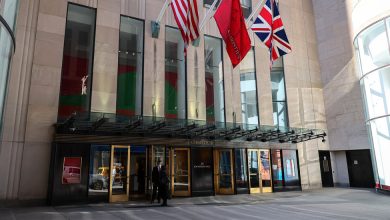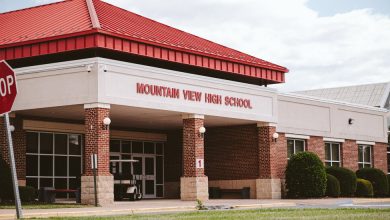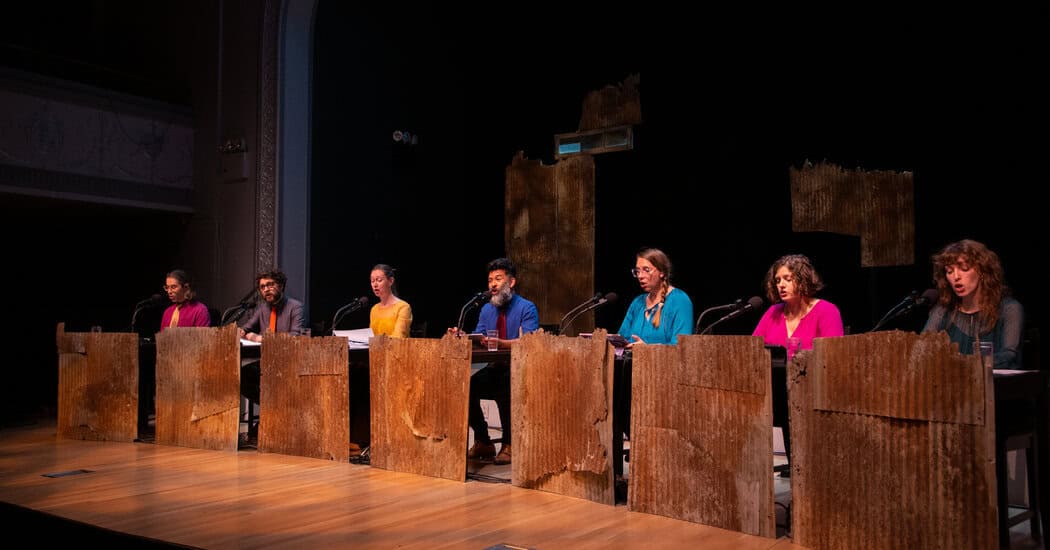‘Gangsta Night’ Was Supposed to Be Fun. Some Thought It Was Racist.

Windsor, N.Y., population 833, is described by residents on Facebook as “that nice rustic town on the Susquehanna River.” Located in the state’s Southern Tier close to the Pennsylvania border, it offers vistas of farmland, dotted with several big clapboard houses painted a duck-egg blue. The closest city is Binghamton, 16 miles away.
The town is “hard to describe,” said Eric Appel, a television director (“Silicon Valley,” “New Girl”), who grew up there in the 1990s. “I mean, it was a beautiful place, but it was very white.” He had one Black classmate in high school, but everyone watched MTV and listened to Dr. Dre and Snoop Dogg, he said. “People were dressing in big, flashy, hip-hop clothes, and it was all, like, white kids doing it, you know?”
A quarter of a century later, students in Windsor seem to still have similar interests, but now they live in a post-George Floyd world, with a heightened awareness of race and diversity in larger cities and on social media. This is why when images of “Gangsta Night,” a student-organized event at a basketball game, surfaced online this winter and spurred a local debate as to whether they were racist,many white residents here seemed surprised and defensive, while people of colorin town interviewed for this story were insulted, and yet not surprised at all.
For Gangsta Night, the participating students, all of them white, pretended to be members of the Crips and the Bloods, notorious rival gangs with origins in Los Angeles. Some had fake teardrop tattoos, others wore shower caps, white tank tops and low-rise jeans that exposed their underwear. One proclaimed he was from the Bronx and another wore a thick chain around his neck. They flashed hand signals and snapped photos and shared them on Snapchat.
Kashif Summers, the coach of the girls’ basketball team and the only Black staff member at the nearly all-white school, said he was horrified when he saw the images. At least half his team — all of his players are white — had participated in the event, he said. When he messaged the athletes on the team’s group chat to express his feelings and disappointment, no one responded.
The local school district said it investigated the theme night in response to complaints on social media. Dr. Jason Andrews, the superintendent of the Windsor Central School District, said that some of the students were found to have violated the school’s dress code and committed “actions of discrimination and you know, violations.” Some faced consequences, he said, but declined to specify what they were.
Still, many in the community defended the event, which is a school tradition featuring dress-up themes in the name of school spirit.
On Facebook, a woman from Binghamton wrote that students were just trying to have fun and that Mr. Summers, the coach, needed to relax. Another commented that students should be able to wear what they want and that restricting clothing styles to a particular race was in itself racist.
Past dress-up events at the school have included “Hawaiian Night,” where students wore Aloha shirts, and “Hillbilly Night,” both of which, according to students and parents, passed without notice. Gangsta Night seems to have been organized haphazardly and at the last minute, and it did not go through an approval process with the school. Dr. Andrews, the superintendent, said, “We would not have authorized that as an appropriate theme” if the idea had been presented to administrators.
For Mr. Summers, who was hired last year, it has been an uphill climb as a Black man trying to explain to white parents and students why the costumes went beyond innocent entertainment and came across as offensive, instead.
“Some of these adults are saying, ‘Oh, you’re just making a fun thing that kids do over clothes as a major issue,’” he said. “But it is a major issue. Let me ask you a question: Are you going to be looked at as a threat in those clothes and get stopped by the police and harassed? If I do it, I’ll get ripped apart.”
He reasoned that part of the problem is the lack of diversity in the school and wider community. “It’s wrong, I don’t like it,” Mr. Summers said. “But if they were never taught that this is wrong, they’re not going to know.”
Although nearly four months have passed since the divisive event, not much has changed at the school in terms of new policies regarding race or even a continuing dialogue. Mr. Summers said a school assembly to address the issue was held, but attendance was optional. Most students, parents, teachers and administrators seem reluctant to discuss what happened at all.
On a recent winter afternoon, a group of white students stood waiting to be picked up by their parents in the parking lot behind the school. Those who spoke with a reporter did not want to share their last names. Drake, 15, chalked Gangsta Night up to a misunderstanding, saying its aftermath was a teachable moment and that students would be more careful in the future.
Adele, 18, added that students were simply trying to be more creative with their theme night ideas. Hillbilly Night, she explained, was about their own community, where most people live in the country and on farms.
But according to some current and former students, particularly those who don’t identify as white, Gangsta Night wasn’t an anomaly but reflected the broader culture of the school, where bullying and harassment of Black and other students of color have been commonplace for years. Out of 1,626 students in the Windsor Central School District, 91 percent are white. Only 22 of them, less than 2 percent, are Black.
Isaac Hyde, who is Black and graduated in 2016, said white students routinely referred to him with a racial slur but were never reprimanded. “The teachers didn’t comment on anything; they wouldn’t stop the racism,” Mr. Hyde said, adding that he recalled a couple of teachers using stereotypes in class about Black people stealing and selling drugs.
Amanda Brown, who graduated in 2018 and is Jewish, recalled a teacher’s reaction to her Hanukkah sweater: “This is America. It’s Merry Christmas.” And when a swastika was discovered in one of her classes, she said, it was removed, “but the school didn’t address it.”
One current Black student who asked not to be identified recalled that a white male classmate sitting next to her called her a racial slur. The teacher told him to move desks but also told her to get a tougher skin. Later in the hallway, the same classmate called her a “cotton picker,” and she heard others talking about dressing up like the Ku Klux Klan for Halloween, she recalled.
Others in the community talked about the struggles of majority-white schools to self-regulate and handle racism within their walls. The Black Lives Matter movement precipitated conversations on racism and racial justice across the country, but how does a school address racist behavior when the message in the community says it does not exist?
The attitude is “not uncommon and speaks to a more pervasive challenge when it comes to white-dominated spaces,” said David Nurenberg, associate professor at Lesley University in Cambridge, Mass., and the author of “‘What Does Injustice Have to Do With Me?’ Engaging Privileged White Students With Social Justice.”
“This persistent belief that many white people hold,” Mr. Nurenberg said, “that the locus of racism lies in the individual, and absent a deliberate and conscious decision by an actor to imbue an act with racism, no racism exists. ‘I didn’t think this act was racist, ergo it wasn’t racist.’”
As a result, he said, many schools are “turning out white students who are unprepared for success in a multicultural world.”
Windsor Central High School and the local district have not issued a public apology or even a statement about Gangsta Night. Some of the two dozen students who participated are children of teachers and coaches employed by the school, and one participant is the daughter of a school district official, who is involved with the investigation. The school principal at the time of the incident, Jeffrey Salasny, who left the position this winter and now works in administration for the Windsor Central School District, and the associate principal, Christopher Klumpp, did not respond to a request for comment.
The New York State attorney general’s office handles race-related cases in schools, but no one from the Windsor district has filed a complaint, so the incident is not being investigated.
Shanel Boyce, who lives in Binghamton and leads racial sensitivity training for school employees in the region, but has yet to be invited to Windsor, said she doubted that her sessions in the area had yielded much meaningful change so far. “It’s a huge problem here. There are a lot of apologies — ‘We’re sorry this happened’ — but there’s no real reform,” Ms. Boyce said. “I would say that a lot of times they do it to check the boxes, but there’s no real change in terms of policy and practice.”
JaVanté Owens, a Black student who graduated in 2017, would agree with Ms. Boyce’s assessment. She recalled a drama class in which she was cast as the ghost of a white soldier. The teacher told her to keep putting talcum powder on her face to look like her white counterparts. “The atmosphere was the most racist and toxic I’ve ever encountered in my entire life,” she wrote on Facebook. “It really affects me even to this day.”
Mr. Summers, the Black coach, said that there had been little resolution since the incident.
“Everything’s still the same,” Mr. Summers said.
“Nothing ever came about it, and it’s like, I don’t understand. You guys said the issues are going to be addressed,” he added. “I feel like a lot of the kids changed for the better, but I don’t think the parents did.”



